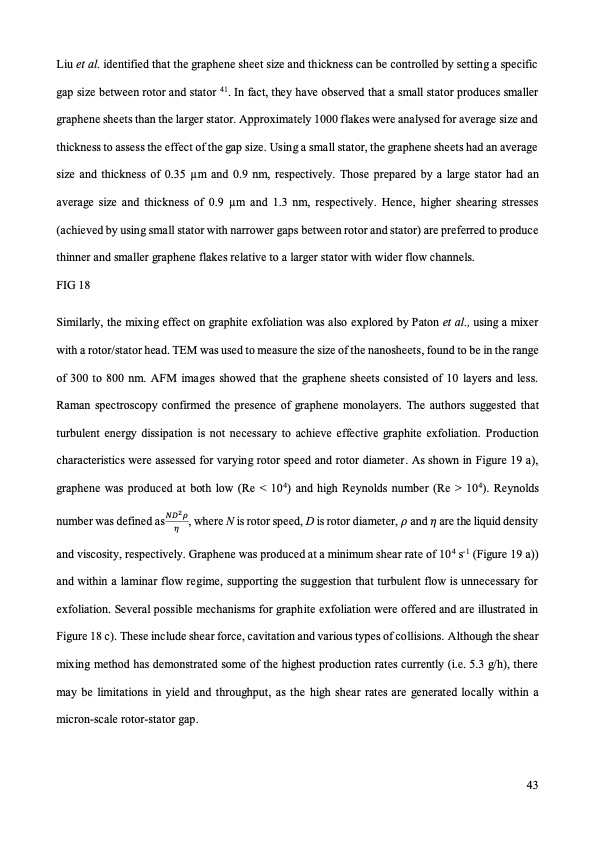
PDF Publication Title:
Text from PDF Page: 043
Liu et al. identified that the graphene sheet size and thickness can be controlled by setting a specific gap size between rotor and stator 41. In fact, they have observed that a small stator produces smaller graphene sheets than the larger stator. Approximately 1000 flakes were analysed for average size and thickness to assess the effect of the gap size. Using a small stator, the graphene sheets had an average size and thickness of 0.35 μm and 0.9 nm, respectively. Those prepared by a large stator had an average size and thickness of 0.9 μm and 1.3 nm, respectively. Hence, higher shearing stresses (achieved by using small stator with narrower gaps between rotor and stator) are preferred to produce thinner and smaller graphene flakes relative to a larger stator with wider flow channels. FIG 18 Similarly, the mixing effect on graphite exfoliation was also explored by Paton et al., using a mixer with a rotor/stator head. TEM was used to measure the size of the nanosheets, found to be in the range of 300 to 800 nm. AFM images showed that the graphene sheets consisted of 10 layers and less. Raman spectroscopy confirmed the presence of graphene monolayers. The authors suggested that turbulent energy dissipation is not necessary to achieve effective graphite exfoliation. Production characteristics were assessed for varying rotor speed and rotor diameter. As shown in Figure 19 a), graphene was produced at both low (Re < 104) and high Reynolds number (Re > 104). Reynolds number was defined as𝑁𝐷2𝜌, where N is rotor speed, D is rotor diameter, 𝜌 and 𝜂 are the liquid density 𝜂 and viscosity, respectively. Graphene was produced at a minimum shear rate of 104 s-1 (Figure 19 a)) and within a laminar flow regime, supporting the suggestion that turbulent flow is unnecessary for exfoliation. Several possible mechanisms for graphite exfoliation were offered and are illustrated in Figure 18 c). These include shear force, cavitation and various types of collisions. Although the shear mixing method has demonstrated some of the highest production rates currently (i.e. 5.3 g/h), there may be limitations in yield and throughput, as the high shear rates are generated locally within a micron-scale rotor-stator gap. 43PDF Image | graphene production via nonoxidizing liquid exfoliation

PDF Search Title:
graphene production via nonoxidizing liquid exfoliationOriginal File Name Searched:
Graphene-R2-review.pdfDIY PDF Search: Google It | Yahoo | Bing
Salgenx Redox Flow Battery Technology: Power up your energy storage game with Salgenx Salt Water Battery. With its advanced technology, the flow battery provides reliable, scalable, and sustainable energy storage for utility-scale projects. Upgrade to a Salgenx flow battery today and take control of your energy future.
| CONTACT TEL: 608-238-6001 Email: greg@infinityturbine.com | RSS | AMP |